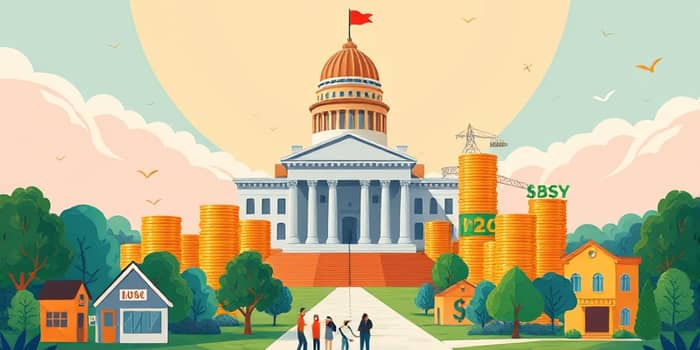
Deficits are more than numbers; they are reflections of a nation’s priorities. By examining spending choices and fiscal outcomes, citizens gain the power to shape a more equitable and secure future. This article unpacks the mechanics, consequences, and solutions for financial flexibility and stability in modern economies.
A budget deficit arises when a government’s expenditures in a given year exceed its revenue. While occasional deficits can stimulate growth during downturns, chronic shortfalls can burden future generations. The cumulative result of repeated deficits forms the national debt—a tally of all outstanding government obligations.
For perspective, the U.S. national debt reached nearly 100 percent of GDP in 2025, amounting to roughly $230,000 per household. In contrast, the post-World War II debt peaked at about 120 percent of GDP before a period of rapid growth reduced that ratio.
Viewing deficits alongside GDP and revenue trends helps illustrate sustainability. A country with steady economic growth can manage moderate deficits, but persistent budget shortfalls and strain risk eroding confidence and raising borrowing costs over time.
In fiscal year 2025, the U.S. budget deficit totaled $1.1 trillion through April, up 13 percent from the previous year. Annual federal spending stands at approximately $7 trillion, funded by roughly $5 trillion in revenue. This gap requires borrowing to finance public services, infrastructure, and safety nets.
Interest costs have surged, tripling since 2017 to levels that eclipse defense and Medicare spending. This shift means more taxpayer dollars flow toward debt service instead of direct public investments.
By 2024, compounding interest payment burdens threaten future spending flexibility.
Examining these numbers reveals how borrowing amplifies budgetary pressures and highlights the importance of sustainable fiscal paths.
Mandatory programs account for over half of total outlays and will expand as demographics shift. Rising life expectancy and healthcare costs fuel the need for long-term planning around benefit levels and funding mechanisms.
Interest costs, driven by both higher rates and larger principal balances, create a feedback loop: borrowing begets more interest, which begets more borrowing. This dynamic can entrench rising national debt levels.
Discretionary spending fluctuations—often responding to unexpected disasters or economic stimuli—add volatility to the budget. Combined with cyclical revenue dips during recessions, these factors illustrate the complexity of achieving balance.
High deficits can crowding out private investments, as government bond issuance absorbs capital that might otherwise fund business expansion or mortgages. Higher interest rates on public debt often translate to steeper borrowing costs for consumers and firms.
Inflation risk grows when deficits are financed by money creation, diluting currency value and eroding savings. For families, this means everyday expenses—from groceries to gas—can climb faster than wages.
Large debt obligations limit policy options during crises. When emergencies arise, such as natural disasters or economic shocks, governments may lack the freedom to launch robust stimulus packages without aggravating existing fiscal pressures. This issue underscores reduced policy flexibility in crises.
Indeed, historical studies find that a one percentage point increase in government spending relative to GDP correlates with a 0.36 point rise in unemployment and a 0.39 point drag on real GDP growth, demonstrating the tangible costs of unchecked deficits.
To bridge fiscal gaps, governments issue Treasury securities—bills, notes, and bonds—sold to domestic and international investors. Auctions determine yields, which reflect perceived risk and future rate expectations. As yields climb, borrowing costs escalate, further straining budgets.
The Federal Reserve’s role adds complexity. Through open market operations, the Fed may purchase government debt to manage liquidity and support economic targets. While stabilizing rates, this practice can expand the monetary base and fuel inflationary pressures if not curtailed.
Understanding these financing channels helps citizens appreciate how decisions today impact tomorrow’s interest bills and tax burdens. Each auction and policy choice sets the stage for future fiscal resilience or vulnerability.
If current trajectories persist, the national debt could swell to 130 percent of GDP within a decade. Annual interest costs would soar toward $2 trillion, crowding out essential investments in education, infrastructure, and research.
Credit rating agencies warn that elevated debt levels heighten the risk of downgrades, which would raise borrowing costs further. A loss of confidence in U.S. Treasury securities could reverberate through global markets, disrupting capital flows and trade.
Without corrective action, policymakers may face stark choices: sharp spending cuts, dramatic tax hikes, or a combination of both. Such 'big, painful disruptions' often occur under duress, amplifying economic and social strains.
Real-world examples show that phased reforms—paired with transparent public debates—can achieve bipartisan support and durable outcomes. Citizens play a key role by engaging in civic processes, advocating for long-term vision over short-term politics.
Effective solutions blend spending discipline with growth strategies, ensuring public services thrive without saddling future generations with unmanageable debt. By fostering a culture of fiscal responsibility, society safeguards prosperity and upholds the social contract.
Budget deficits and national debt may seem distant or technical, but their consequences touch every household and business. Awareness of underlying drivers, risks, and remedies empowers individuals to influence policy and vote in line with their values.
As stewards of our nation’s financial health, we share a responsibility to demand transparency, advocate for balanced budgets, and support leaders who prioritize both growth and sustainability. Through informed engagement, we can secure a stable economic legacy for ourselves and generations to come.
References













